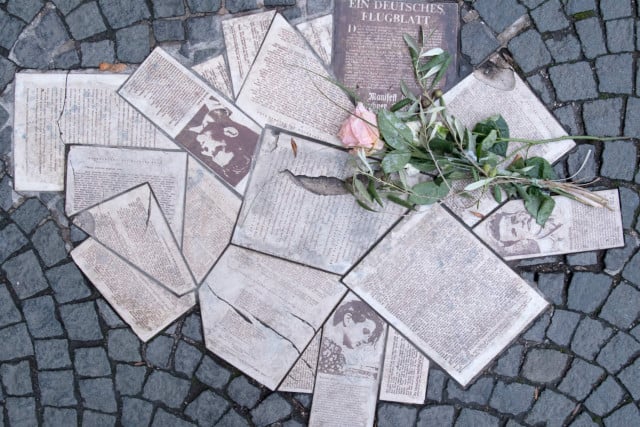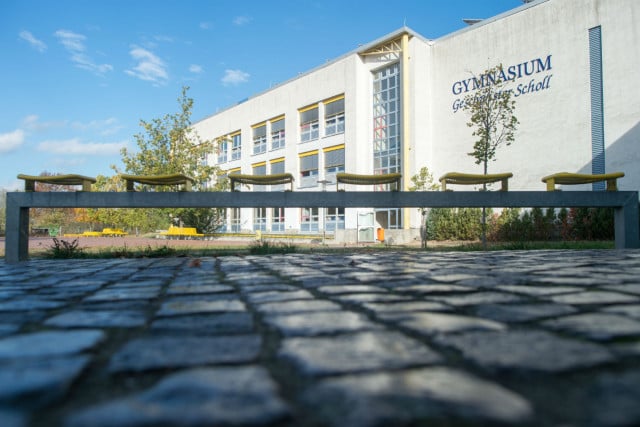What we can learn from the White Rose siblings

Friday marks 76 years since the young White Rose activists were executed by Nazis in Munich’s Stadelheim Prison for denouncing Hitler's regime. Who were they and how do they inspire heroism today?
The Scholl siblings - Sophie and Hans - and their friend Christoph Probst were one part of a larger network of students and young people across southern Germany. All came to believe that the Nazi regime was waging an un-winnable, immoral war, and elected to do something about it.
The Scholls and Christoph Probst were students of the Ludwig-Maximilians-Universität München in the early forties. Christoph and Hans were studying to become doctors there, while Sophie hoped to add to her previous studies, to become a teacher, by studying more about philosophy and biology.
Additionally, Hans had military experience, having served on the Eastern Front, where he had witnessed atrocities being carried out.
Using a small printing press they had managed to get their hands on, and drawing on their studies of morality and ethics, starting in late 1942, the members of the White Rose wrote a series of pamphlets denouncing Hitler’s regime, laying out in detail the tremendous cost of the war physically and morally.

A memorial left for the Scholl siblings at Ludwig-Maximilians-Universität in Munich in November 2018. Photo: DPA
Once written, each pamphlet was typeset and printed in significant quantities. Brave members of the group then carried leaflets to places like Stuttgart, Hamburg and Berlin in their luggage, where they would be left in public places for people to pick up.
A trail of leaflets
Over the course of months, the ‘White Rose’ were careful in their work, hoping not to reveal the source of the leaflets. However, as news of the defeat at Stalingrad broke, and a riot was sparked on the university campus by remarks made by the local Gauleiter, the group grew more confident, expanding to leaving stenciled slogans on walls in the dead of night.
Capture, therefore, was a case of when, not if. On February 18th 1943, Sophie and Hans went to the university in Munich to drop off some leaflets. After leafleting the main halls during classes, the pair found that they had some left over, which they flung over a railing. At this point they were spotted by a janitor, who had them arrested.
Under questioning, Sophie and Hans both attempted to take the blame on themselves, but analysis of the handwriting on one of the leaflets led them to Christoph the same day. Three days later, on the 22nd of February, they faced the Volksgerichtshof - the People’s Court, overseen by the notorious Roland Freisler, a fanatical Nazi.
After a brief, summary kangaroo trial, during which Fresler harangued the three as traitors to the Reich, a sentence of death was pronounced on all three. They would be beheaded by guillotine the very same day.
The last words of the Scholl siblings, as they were led to the guillotine have survived down the decades, and continue to speak to us.
Sophie’s were the following: “Such a fine, sunny day, and I have to go, but what does my death matter, if through us thousands of people are awakened and stirred to action?”
Hans’ were arguably more direct, but no less potent: ‘Long live freedom!’.
There would be other trials, and others associated with the White Rose executed as the war progressed, but the story of Probst and the Scholls quickly made its way out of the country. Copies of the leaflets were smuggled into Britain, where they were reproduced and dropped by American bombers over German cities.
Commemoration throughout Germany
In the years after the war, the White Rose have been commemorated by a number of monuments.
Leaflets left as a memorial for the Scholl siblings in November 2018 at Ludwig-Maximilians-Universität in Munich. Photo: DPA
In Munich, you can visit the Geschwister-Scholl-Platz, outside the university buildings they leafleted. There’s a memorial in the form of leaflets embedded in the pavement.
Inside the university itself, you can visit a permanent exhibition dedicated to the group, with original documents and photos belonging to the Scholls and Probst. The courtroom where the trio were sentenced, inside the Munich Palace of Justice, also has an exhibition focusing on the White Rose.
Additionally, across Germany and beyond, there are hundreds of streets, buildings and schools named after them, and their memory is also honoured in awards, stamps and other public events.

A school in Gardelegen in Saxony-Anhalt, one of the many named after the Schloll siblings. Photo: DPA
At a time when Far Right populism is on the rise, and we find ourselves all too swayed by the easy, hateful solutions, the Scholls and Probst remind us of the power in standing up.
They remind us that doing the right thing is difficult, often dangerous, but vital in the struggle against tyranny and despotism.
Finally, they remind us we all have the capacity to be heroes, even in the darkest of times.
EXPLORE:
-
Geschwister-Scholl-Platz / Geschwister-Scholl-Platz, 80539 Munich
-
White Rose Memorial/DenkStätte Weiße Rose/Geschwister-Scholl-Platz 1, 80539 Munich
-
Palace of Justice/Justizpalast / Prielmayerstrasse 7, 80335 Munich
Comments
See Also
The Scholl siblings - Sophie and Hans - and their friend Christoph Probst were one part of a larger network of students and young people across southern Germany. All came to believe that the Nazi regime was waging an un-winnable, immoral war, and elected to do something about it.
The Scholls and Christoph Probst were students of the Ludwig-Maximilians-Universität München in the early forties. Christoph and Hans were studying to become doctors there, while Sophie hoped to add to her previous studies, to become a teacher, by studying more about philosophy and biology.
Additionally, Hans had military experience, having served on the Eastern Front, where he had witnessed atrocities being carried out.
Using a small printing press they had managed to get their hands on, and drawing on their studies of morality and ethics, starting in late 1942, the members of the White Rose wrote a series of pamphlets denouncing Hitler’s regime, laying out in detail the tremendous cost of the war physically and morally.

A memorial left for the Scholl siblings at Ludwig-Maximilians-Universität in Munich in November 2018. Photo: DPA
Once written, each pamphlet was typeset and printed in significant quantities. Brave members of the group then carried leaflets to places like Stuttgart, Hamburg and Berlin in their luggage, where they would be left in public places for people to pick up.
A trail of leaflets
Over the course of months, the ‘White Rose’ were careful in their work, hoping not to reveal the source of the leaflets. However, as news of the defeat at Stalingrad broke, and a riot was sparked on the university campus by remarks made by the local Gauleiter, the group grew more confident, expanding to leaving stenciled slogans on walls in the dead of night.
Capture, therefore, was a case of when, not if. On February 18th 1943, Sophie and Hans went to the university in Munich to drop off some leaflets. After leafleting the main halls during classes, the pair found that they had some left over, which they flung over a railing. At this point they were spotted by a janitor, who had them arrested.
Under questioning, Sophie and Hans both attempted to take the blame on themselves, but analysis of the handwriting on one of the leaflets led them to Christoph the same day. Three days later, on the 22nd of February, they faced the Volksgerichtshof - the People’s Court, overseen by the notorious Roland Freisler, a fanatical Nazi.
After a brief, summary kangaroo trial, during which Fresler harangued the three as traitors to the Reich, a sentence of death was pronounced on all three. They would be beheaded by guillotine the very same day.
The last words of the Scholl siblings, as they were led to the guillotine have survived down the decades, and continue to speak to us.
Sophie’s were the following: “Such a fine, sunny day, and I have to go, but what does my death matter, if through us thousands of people are awakened and stirred to action?”
Hans’ were arguably more direct, but no less potent: ‘Long live freedom!’.
There would be other trials, and others associated with the White Rose executed as the war progressed, but the story of Probst and the Scholls quickly made its way out of the country. Copies of the leaflets were smuggled into Britain, where they were reproduced and dropped by American bombers over German cities.
Commemoration throughout Germany
In the years after the war, the White Rose have been commemorated by a number of monuments.
Leaflets left as a memorial for the Scholl siblings in November 2018 at Ludwig-Maximilians-Universität in Munich. Photo: DPA
In Munich, you can visit the Geschwister-Scholl-Platz, outside the university buildings they leafleted. There’s a memorial in the form of leaflets embedded in the pavement.
Inside the university itself, you can visit a permanent exhibition dedicated to the group, with original documents and photos belonging to the Scholls and Probst. The courtroom where the trio were sentenced, inside the Munich Palace of Justice, also has an exhibition focusing on the White Rose.
Additionally, across Germany and beyond, there are hundreds of streets, buildings and schools named after them, and their memory is also honoured in awards, stamps and other public events.

A school in Gardelegen in Saxony-Anhalt, one of the many named after the Schloll siblings. Photo: DPA
At a time when Far Right populism is on the rise, and we find ourselves all too swayed by the easy, hateful solutions, the Scholls and Probst remind us of the power in standing up.
They remind us that doing the right thing is difficult, often dangerous, but vital in the struggle against tyranny and despotism.
Finally, they remind us we all have the capacity to be heroes, even in the darkest of times.
EXPLORE:
-
Geschwister-Scholl-Platz / Geschwister-Scholl-Platz, 80539 Munich
-
White Rose Memorial/DenkStätte Weiße Rose/Geschwister-Scholl-Platz 1, 80539 Munich
- Palace of Justice/Justizpalast / Prielmayerstrasse 7, 80335 Munich
Join the conversation in our comments section below. Share your own views and experience and if you have a question or suggestion for our journalists then email us at [email protected].
Please keep comments civil, constructive and on topic – and make sure to read our terms of use before getting involved.
Please log in here to leave a comment.